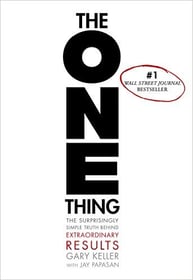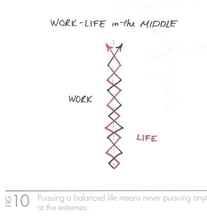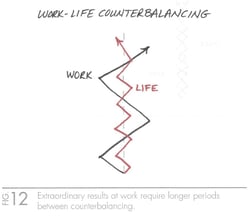It’s a common theme this time of year. We get out of balance chasing the spirit of Christmas, giving presents.
After picking up my son Joshua from Iowa State on Saturday, he said, “I’m just trying to please everyone Dad!”
I’m not sure he captured what I told him next. “Josh” I responded, “you can’t please everyone; you need to please yourself first. That may sound selfish, yet it’s exactly what they instruct you to do on an airplane. Make sure you have your mask on first before helping someone else. The only way to be able to please anyone else is to first make sure you are happy.”
Roy Masters says it best, “You can’t please everyone anyway, so stop trying. You are responsible only for expressing the truth for each moment. If others become upset over your honesty, then they will see their own faults in the light of your patient nature.”
 Is it possible to live a balanced life? Again we are reviewing the Six Lies that keep us from achieving our One Thing from Gary Keller’s The ONE Thing: The Surprisingly Simple Truth Behind Extraordinary Results.
Is it possible to live a balanced life? Again we are reviewing the Six Lies that keep us from achieving our One Thing from Gary Keller’s The ONE Thing: The Surprisingly Simple Truth Behind Extraordinary Results.
Keller shared six lies about success that keep us from living the One Thing:
- Everything Matters Equally
- Multitasking
- A Disciplined Life
- Willpower Is Always on Will-Call
- A Balanced Life
- Big Is Bad
Today we will explore Keller’s answer to:
A Balanced Life is a lie.
How do you achieve a balanced life if you believe in Josh Billings quote, “Be like a postage stamp— stick to one thing until you get there?”
Another quote may help you make sense of this.
“The truth is, balance is bunk. It is an unattainable pipe dream... The quest for balance between work and life, as we’ve come to think of it, isn’t just a losing proposition; it’s a hurtful, destructive one.” —Keith H. Hammonds
Keller notes: “Nothing ever achieves absolute balance. Nothing. No matter how imperceptible it might be, what appears to be a state of balance is something entirely different— an act of balancing. Viewed wistfully as a noun, balance is lived practically as a verb. Seen as something we ultimately attain, balance is actually something we constantly do. A “balanced life” is a myth—a misleading concept most accept as a worthy and attainable goal without ever stopping to truly consider it. I want you to consider it. I want you to challenge it. I want you to reject it. A balanced life is a lie.”
He continues: “The idea of balance is exactly that—an idea. In philosophy “the golden mean” is the  moderate middle between polar extremes, a concept used to describe a place between two positions that is more desirable than one state or the other. This is a grand idea, but not a very practical one. Idealistic, but not realistic. Balance doesn’t exist.”
moderate middle between polar extremes, a concept used to describe a place between two positions that is more desirable than one state or the other. This is a grand idea, but not a very practical one. Idealistic, but not realistic. Balance doesn’t exist.”
Look at the picture on the right showing how your life might look like in balance.
The book points out that a balance life idea really is a recent idea. It was coined in the mid-1980’s, about the time half of all married women joined the workforce.  The chart at the left shares how the term balanced life had mushroomed in the last couple of years appearing in 32 articles in 1986 compared to articles 1674 in 2007.
The chart at the left shares how the term balanced life had mushroomed in the last couple of years appearing in 32 articles in 1986 compared to articles 1674 in 2007.
A balanced life can seem so serene and peaceful. Because of this, we believe that’s the way life was meant to be. But it’s not! If you think of balance as living in the middle, then when you are on either side of the middle you are out of balance. So what’s the problem with that? Living in the middle prevents you from making extraordinary time commitments to anything. In an effort to attend to all things, everything gets shortchanged. Nothing gets its due.
Working the Extremes
You might believe you can achieve balance by working at the extremes. Keller shares a story of a very successful businessman who worked long hours, often weekends, sincere in his belief that he was doing this for his family. When he finished being successful he believed he’d enjoy the fruits of his work. He’d then enjoy time to travel with his family, and do all the things he’d never done. After selling his business Keller inquired about what he might do now. Keller asked how he was doing to which he responded, “When I was building the business, I was never home and rarely saw my family. So now I’m with them on vacation making up for lost time. You know how it is, right? Now that I have the money and the time, I’m getting those years back.”
Keller asks the following questions: Do you really think you can ever get back a child’s bedtime story or birthday? Is a party for a five-year-old with imaginary pals the same as dinner with a teenager with high-school friends? Is an adult attending a young child’s soccer game on par with attending a soccer game with an adult child? Do you think you can cut a deal with God that time stands still for you, holding off on anything important until you’re ready to participate again?
That’s the issues when working the extremes. Gambling with your time is placing a bet you can’t cover. As the successful businessman story points out, even if you win, can you live with what you lose?
How do you achieve balance, or how do you live your life to achieve some semblance of balance then? I loved this idea from James Patterson novel Suzanne’s Diary for Nicholas, “Imagine life is a game in which you are juggling five balls. The balls are called work, family, health, friends, and integrity. And you’re keeping all of them in the air. But one day you finally come to understand that work is a rubber ball. If you drop it, it will bounce back. The other four balls—family, health, friends, integrity—are made of glass. If you drop one of these, it will be irrevocably scuffed, nicked, perhaps even shattered.”
Counterbalance
So if achieving balance is a lie, then what do you do? Counterbalance. Replace the word “balance” with “counterbalance” and what you experience makes sense. The things we presume to have balance are really just counterbalancing. The ballerina is a classic example. When the ballerina poses en pointe, she can appear weightless, floating on air, the very idea of balance and grace. A closer look would reveal her toe shoes vibrating rapidly, making minute adjustments for balance. Counterbalancing done well gives the illusion of balance.
There are two types of counterbalancing: the balancing between work and personal life, and the balancing within each.
Professional success is not about how much overtime you put in. Instead, the key ingredient is focused time over time. To achieve an extraordinary result, choose what matters most, then give it all the time it demands. It requires getting extremely out of balance in relation to all other work issues, with only infrequent counterbalancing to address them.
Your Personal world requires awareness as the essential ingredient. Keller offers, “Awareness of your spirit and body, awareness of your family and friends, awareness of your personal needs—none of these can be sacrificed if you intend to “have a life,” so you can never forsake them for work or one for the other. You can move back and forth quickly between these and often even combine the activities around them, but you can’t neglect any of them for long. Your personal life requires tight counterbalancing.”
Whether or not to go out of balance isn’t really the question. The question is: “Do you go short or long?”
In your personal life, go short and avoid long periods where you’re out of balance.
In your professional life, go long and make peace with the idea that the pursuit of extraordinary results may require you to be out of balance for long periods. Going long allows you to focus on what matters most, even at the expense of other, lesser priorities.
An extraordinary life is a counterbalancing act.
BIG IDEAS
- Think about two balancing buckets. Separate your work life and personal life into two distinct buckets—not to compartmentalize them, just for counterbalancing. Each has its own counterbalancing goals and approaches.
- Counterbalance your work bucket. View work as involving a skill or knowledge that must be mastered. This will cause you to give disproportionate time to your ONE Thing and will throw the rest of your work day, week, month, and year continually out of balance. Your work life is divided into two distinct areas—what matters most and everything else. You will have to take what matters to the extremes and be okay with what happens to the rest. Professional success requires it.
- Counterbalance your personal life bucket. Acknowledge that your life actually has multiple areas and that each requires a minimum of attention for you to feel that you “have a life.” Drop any one and you will feel the effects. This requires constant awareness. You must never go too long or too far without counterbalancing them so that they are all active areas of your life. Your personal life requires it






.jpeg?width=150&height=135&name=Hand%20with%20marker%20writing%20the%20question%20Whats%20Next_%20(1).jpeg)

